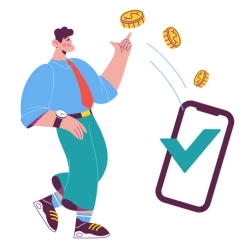If you currently own a business or are thinking of starting one, it’s important you understand the payment reversal process. In this article, we touch on the different types of payment reversals, how long they take, and—most importantly—how to protect your business from excessive or fraud-related payment reversals.
What Does Payment Reversal Mean?

Although the phrase “payment reversal” may sound complicated, it’s something you have probably experienced before. If you have ever returned an item and received a refund, that’s a payment reversal. (Not all that complicated, right?)
The simplest and most generic way to describe a payment reversal is that it’s the occurrence of a merchant giving money back to a customer. As you can probably imagine, there are many situations fitting this description. Below, we identify the different scenarios warranting a payment reversal.
What causes a transaction to be reversed?
As we alluded to, there are many reasons to reverse transactions. These reasons can range from something as simple as a merchant’s error to a customer’s mistake. Below are a few payment reversal scenarios:
Merchant Caused
- Payment Mistake: The customer was charged the wrong amount, commonly caused by adding or omitting a zero or tapping the wrong key.
- Duplicate Charge: A customer was charged more than once for the same transaction.
Operations Caused
- Incorrect Advertising: The customer is unsatisfied because the product purchased is not as described.
- Inaccurate Inventory: A customer purchased an out-of-stock item because the website was not up to date.
Customer Caused
- Fraud: The customer claims the charge was fraudulent.
- The Customer Changed Their Mind: This occurs when a customer simply returns an item or cancels their order.
The Three Types of Payment Reversals
Now that you are up to speed with some of the most common causes of payment reversals, it’s time to understand the type of reversal you might need to use in your business operations. There are three common categories into which payment reversals fall: authorization reversals, refunds, and chargebacks. The one you should use depends on a few things, including your refund policy, the underlying issue, and the timing of the reversal.
1. Authorization Reversal
An authorization reversal is a refund of money from the credit card processor to the customer. This type of payment reversal usually occurs when a merchant cancels a transaction after it’s already been authorized but before it has been settled. This means the batch is still open, and the charge shows as pending on the customer’s bank account statement.
For example, suppose a customer decides to add a quick item at the checkout counter. In that case, a merchant may cancel the original approval and charge the correct amount instead of running a second transaction for the additional item.
Behind the scenes of an authorization reversal, the credit card processor contacts the card issuing bank and requests for funds to be moved back to the customer’s account. The processor basically acts as an intermediary for pending transactions, ensuring all reversals are well-timed and accurate so customers aren’t inconvenienced.
Additionally, you may also need to reverse an authorization in the event of an authorization hold. Bar tabs and security deposits are two common examples of authorization holds. When you close the tab out, you’ll reverse the hold and charge the correct amount.
2. Refund
A refund happens when a customer gets their money back for something they previously purchased. If the original purchase took place via credit card, a merchant can initiate the refund process through their credit card processor. At this point, the processor interacts with your customer’s bank to remit part or all of their payment. This process can be relatively swift, with refunds usually processed in just a few days.
3. Chargebacks
While seemingly similar, chargebacks and refunds are not one and the same. Both processes can result in returning money to customers, but the difference is that chargebacks can have adverse effects on your business, whereas refunds typically have no impact other than the lost sale.
Put into place by the Fair Credit Billing Act, chargebacks are a way for cardholders to dispute items they’ve purchased via credit card. Usually used as a last resort, a chargeback is essentially a mini-court case to determine who rightfully should get the money from a disputed transaction. Credit card processors refund the disputed amount immediately, after which the mini-court case plays out.
In the event of a chargeback, the merchant incurs a chargeback fee and possibly other fines, depending on each situation. The processor may take additional steps if they think a merchant has engaged in unfair or deceptive practices, resulting in excessive chargebacks. Ultimately, an increased chargeback rate can be very costly for you.
How Long Does a Payment Reversal Take?
The period of time a payment reversal takes is based on the type of reversal. For example, authorization reversals are the quickest, typically only taking two to four days to complete. Sometimes, the authorization will even drop from the customer’s bank account on the same day. Refunds, on the other hand, can be a bit more complicated. You’ll need to handle returns and ensure that the reason and conditions for the return fit your business’s return policy before the refund occurs.
Finally, a chargeback takes the longest to run its course—especially if you choose to fight the case. Chargebacks are typically resolved within 90 days, but the timeline can be shorter or longer, depending on the dispute processes.
How You Can Protect Your Business From Funding Reversals
Authorization reversals and refunds are a normal part of running a business. Reviewing your product descriptions, shipping & packaging safety, and marketing practices can be helpful if you’re experiencing an uptick in refund requests.
Focusing your energy on avoiding fraud is also key. Fraud is a costly element of the modern business landscape. Poor fraud detection can result in a high volume of chargebacks and costly payment reversals. However, you can do a couple of things to help protect your business from fraudulent payment reversals. Let’s review them below:
Deflection
Deflection has become increasingly popular among merchants because of its positive impact on revenue protection. It takes a proactive approach to friendly fraud prevention by allowing merchants to send additional information for customers’ banking statements and also takes very little time.
Such additional information includes descriptions of the products or services provided. The point of adding additional information is to help your customers recognize the charge and “deflect” future disputes. If dispute deflection is successful, there usually aren’t additional fees for merchants.
Representment
If you decide to fight a dispute, you enter a representment process. If your customer claims to have never received the product you sent but has signed proof of delivery, you can represent your case through this process. The best way to prepare your business for representment is to:
- Never skip terminal prompts. If your payment device asks for a zip code, make sure to enter one.
- Keep your receipts. You can use this to compare signatures or as proof of a sale.
- Have fraud checks in place. Review business practices to ensure your operations are secure.
- Clarify policy terms and product descriptions. This will help you prove that the product was as described.
Tips to Help Merchants Minimize Payment Reversal Threats
Although it may be impossible to avoid payment reversals altogether, there are steps you can take to reduce their frequency. Below are a few of the most effective ways to prevent payment reversals:

- Make sure your billing descriptors are explicit. It’s important that customers understand the bill is coming from you. You can do this by adding product descriptions, including brand names, or ensuring your business name shows up on your statement descriptors. For example, make sure the DBA (Fancy Nail Salon) shows instead of the legal name (Smith Sisters LLC).
- If a legitimate dispute happens (a refund request or a duplicate charge), be sure to process the request quickly. Getting customers their money as soon as possible is the best way to avoid chargebacks.
- Try to avoid making errors. Although human errors are not always preventable, make sure you have a system in place limiting the number of errors that can occur. You can also integrate a payment system to reduce the number of manual entries required to complete transactions.
At the end of the day, payment reversals are a natural part of accepting payments as a merchant. They come in different forms, some being more worrisome for merchants than others. If you find yourself experiencing chargebacks frequently, it’s important to find a processor with the right chargeback protection tools for your business. This way, you’ll be able to prevent pesky payment reversals from happening, and you can focus on what matters most!
Charge ahead of your competition with chargeback protection!
Secure
FAQs About Payment Reversals
What is the difference between a refund and a reversal transaction?
A refund is a type of transaction reversal where money is given back to a customer. A reversal transaction is any transaction that is reversed.
What is the meaning of a duplicate transaction reversal?
A duplicate transaction reversal occurs when an identical payment has been made twice and the extra one is canceled or refunded back. This normally happens when buyers or cashiers erroneously hit “submit” multiple times for the same purchase.
What is a reverse debit card purchase?
Just like a regular payment reversal, a reverse debit card purchase is when the merchant returns the customer’s money to their bank. The difference between a debit and a credit card in this situation is that the reversal appears as a credit on the account identical to the original purchase.[1]Sapling. “What Is a Reverse Debit Card Purchase? | Sapling”. Accessed January 11, 2023.
What does pre-authorized debit reversal mean?
If you’ve pre-authorized a debit card, it can be harder to reverse the sale than it would be on a credit card. If you notice you or your staff made an entry mistake, for example, you’ll have to contact your processor or bank to initiate a reversal/refund.
How long will a pending authorization take?
It can be tricky to figure out exactly how long a pending authorization will take, as it often depends on the specific circumstances involved. While there is no specific timeline for every authorization, you can generally expect it to take anywhere from one to 30 days, but most often only two or three days.
Can a cardholder cancel a pre-authorization?
Yes, the cardholder can always request to cancel or stop a pre-authorization. This process may take a few days, but the process is definitely doable.
Can you reverse an EFT?
An electronic funds transfer (EFT) is a popular and convenient way of sending money between two bank accounts. While EFTs are fast and tend to have security benefits, you can only undo them with consent from both banks.
What is a temporary credit reversal?
A temporary credit reversal is when a credit card issuer or other financial institution reverses a credit transaction for a certain amount of time on the buyer’s account. This may be done for a variety of reasons, but most commonly it’s done in the event of a chargeback.






